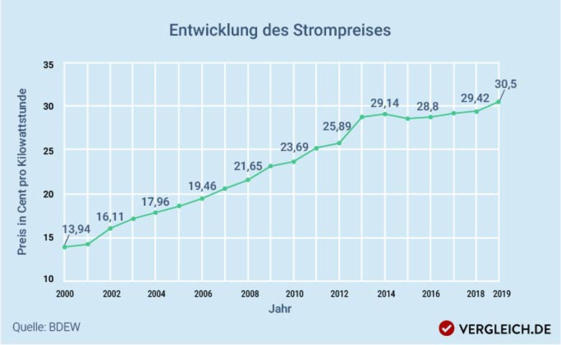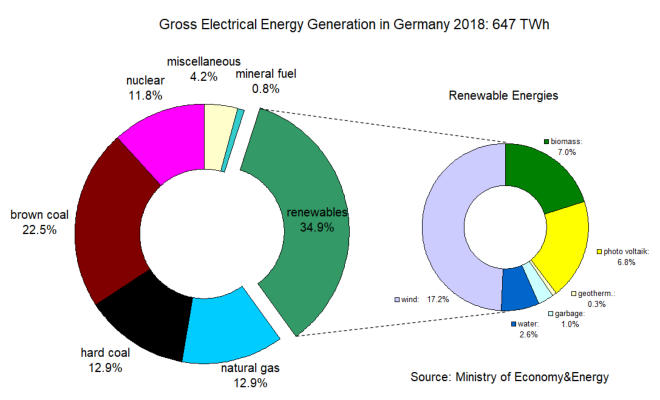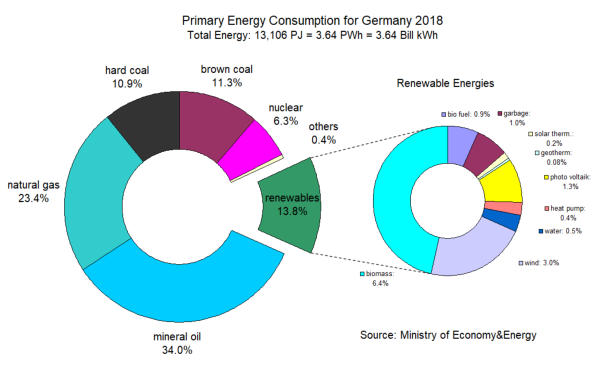
The German Way or the CO
2
Delusion and its Consequences
Download as PDF-file: English or German. See also: Opinion on a “Draft Law for Further Development of the Greenhouse Gas Reduction Rate“ as Invited Expert at a Hearing of the German Parliament‘s Committee for Environment, Nature Conservation and Nuclear Safety. Download as PDF: English or German.Stepwise Exit from Fossil Fuels
In 2018 the Intergovernmental Panel on Climate Change (IPCC) [1] published a “Special Report on possible impacts of global warming of 1.5°C above pre-industrial levels and related global greenhouse gas emission pathways“ [2]. This report is a sequel of previous Assessment Re- ports, which besides many alarmistic exaggerations also presents Representative Concentra- tion Pathways (RCPs) for reducing anthropogenic CO 2 emissions to restrict global warming to 1.5°C over the 21st century. A temperature increase less than 2°C, better only 1.5°C, was re- commended and decided on the 21st Conference of Parties (COP 21) of the United Nations Framework Convention on Climate Change (UNFCCC). This decision is known as the Paris Agreement [3] and considered as the succeeding consent of the Kyoto Protocol [4]. The RCPs, which are accepted by almost all member states of the UNFCCC (with temorary restrictions by the USA), are simulations of simple climate models based on unrealistic and speculative assumptions for the CO 2 climate sensitivity (temperature increase at doubled CO 2 concentration; see Harde 2014 [5], Harde 2017a [6]) and also for the carbon cycle (Harde 2017b [7], Harde 2019 [8]). These RCPs prognosticate a significantly too high temperature increase with rising CO 2 concen- tration, and they exclusively trace the ascending CO 2 concentration back to human emissions, while any natural contributions to the temperature and concentration growth are completely neglected. Independent of the question how strong human emissions of CO 2 and other greenhouse gases can really impact our climate and destroy our planet (we will discuss this in Subsection: Own Climate Studies a) to e) ), we have to look critically to the energy politics of some industria- lized states which ratified the Paris Agreement and already started to shut-down conventional power plants without caring about a reliable and affordable replacement of this energy and without caring about the consequences. As an example for such a misdirected politics we consider Germany; with some smaller modifications this situation also applies to countries like France, Great Britain, Australia or even the United States, when they decide for the same politics.Kyoto-Protocol: Only for clarification a short remembrance of the agreement of the UNFCCC-
member states in 1997, which is known as the Kyoto-Protocol [4]. Although it followed a long
ratification process till this agreement became effective in 2005, many politicians word wide
announced to abstain from fossil energy sources or to reduce their use in order to restrict
global warming by anthropogenic greenhouse gases, which by some climate experts alone are
made responsible for an observed climate change.
According to the Kyoto agreement all member states of the UNFCCC committed • to reduce the emissions of carbon dioxide up to 2012 by at least 5% compared to the level of 1990, • and for the period 2012 – 2020 the European Union obliged to reduce the emissions by 20% till 2020. The German Government even declared as self-commitment • to cut emissions till 2012 down by 20% and till 2020 by 40%. • According to the National Climate Protection Agreement Germany wants to stop all fossil fuel emissions until the mid-century. When the emission of one of the industrialized countries and the European community is above the targets, they are required to engage in emissions trading, i.e. buying CO 2 -certificates from another participant country, which is able to exceed its reduction targets in order to off- set. In this way climate protection shall be realized on market-oriented structures and prac- ticed most economically.Energy Consumption of Germany
Let‘s look closer to the energy balance of Germany and its efforts to become “climate neutral“ in 2050. Over recent years the Primary Energy Consumption (PEC) of Germany was relatively constant. In 2017 this were 13,525 PJ and in 2018 13,106 PJ = 3.64 PWh (Peta Watt*hour) (Ministry of Economy&Energy [9]). Due to transfer processes and a limited efficiency in converting energy from one form to another, typical losses from PEC to the Final Energy Consumption (FEC) are 35%. Here we use the data from 2018, which are meanwhile available. Up to now by far the largest energy supply is ensured by fossil fuels like mineral oil, natural gas and coal, while the so-called renewable energies are only contributing 13.8%. From these, bio- mass with 6.4% is the largest part, but experts assume a further increase is strongly limited. The same holds for water power. So, there comes up the fundamental question, how far wind power and photo voltaic - in 2018 together not more than 4.3% - can really replace reliable sources like fossil fuels and also nuclear power. In 2018 the renewables altogether were just increasing by 0.6%. For generating electric power the fraction of renewables, after all, could be improved by 1.7% in 2018 and rose to 34.9%. But even further increasing the nominal wind power from actually 60 GW to 100 GW in 2030, as planned by the German Net Agency, and assuming the same consumption of 647 TWh per year as nowadays, regenerative energies can only cover 300 TWh (17.2% from 647 TWh times 100/60 for wind energy: 185.5 TWh, and 17.5% from other renew- ables: 114.5 TWh), which is less than 50% of the required electric energy, and 16% of the primary energy. In addition, realistically we have to expect that with reduced fossil fuel and nuclear energy the need for electric energy is substantially increasing, and it remains the basic question, how this missing energy is generated and financed.Increasing Energy Costs and Installations
It is clear that under emissions trading the energy suppliers and the industry with higher CO 2 - emissions have to bear further substantial costs, which finally have to be paid by customers. Additional significant costs are arising from the short-dated decision of the German Govern- ment to shutdown eight nuclear power plants and the remainder by 2022, this as a reaction on the most powerful earthquake and Tsunami in modern times, which struck Japan in March 2011 with disastrous repercussions and destructions of the nuclear power plant in Fukushima. The missing power had to be replaced by new coal and gas power plants, so that an inten- ded reduction of CO 2 -emissions was not realizable - just opposite - at least temporarily. With this decision, in fact, Germany strongly distinguishes from France and the States, even from Sweden, which actually practices the exit from the exit and invests in the renewal of their nuclear power plants. At present nuclear energy is still contributing 6.3% to the PEC of 3.64 PWh, and coal as local resources delivers 22.2%. But under the actual political situation and the pressure of some climate demonstrations like “Fridays for Future“, in May 2019 the German Government decided, also to exit from coal till 2038. So, Germany completely focuses on regenerative power from wind mills and solar panels, for a transient period also on natural gas. But with the objective of zero CO 2 -emissions in 2050 not only nuclear power and coal, yet also the largest energy suppliers, mineral oil with 34% and natural gas with 23.4% have to be replaced. How can this work? Renewable energy is very expensive, not reliable and not available in sufficient extent (see above). The same holds for the required power grid. Some Rough Estimate: Biomass and water as renewables are strongly limited, also photo voltaic cannot really contri- bute to a better energy balance, particularly not over the winter seasons.Remains the wind power!
In 2018 Germany had 30,520 Wind Power Plants (WPPs) (BWE [10), which were generating 111 TWh = 111 Bill kWh of electric energy (3.0 % of PEC). To cover the missing 85.9% (mineral oil 34.0%; natural gas 23.4%; coal 22.2%; nuclear 6.3% - see above diagram), which is 3.13 PWh, this would require 857,570 additional WPPs, each delivering 3.65 GWh over one year or in average 417 kW. This is not more than 20% of a wind turbine with a nominal power of 2 MW. These 20% are only realizable with priority feed into the net and with conventional power plants at standby. As wind power generation with its extremely strong variations due to weather conditions by far not coincides with the daily and seasonal power consumption, the electric power grid can only be operated with an extensive storage technology for renewables, e.g., wind electricity to hydrogen- or methane-gas, to counterbalance these variations in production and consumption over the year. Up to now the respective storage technologies are not available, but when they should be ready for use, the conversion process back and forth with an estimated efficiency of 30 to 40% will further reduce the overall efficiency of the wind power supply to about 10%. When mineral oil and natural gas is no longer available for transportation and heating, a sig- nificant extra demand of electricity and respective storage technology is necessary, which with the low conversion efficiency requires to further increase the number of WPPs. Based on the preceding considerations and assuming that in 2050 an appropriate storage technology already exists and the final energy consumption is not increasing over the next years or can even further be reduced by higher conversion efficiencies from PEC to FEC, in 2050 Germany requires 1.5 to 2 Mio WPPs, each with a nominal power of 2 MW, to ensure a sufficient energy supply. In the worst case this could even be more. This also means that over the next 30 years 60,000 new WPPs per year or 165 WWPs per day have to be installed. But we will just make it, sure! After all, Germany is well-known for its short approval procedures for built-up and rede- signation of floor space. Expropriation of properties in favor of the public can quickly be realized. And with Chinese credits, know-how and support we can manage this. Germany comprises a total area of 360,000 km 2 , i.e., in average each km 2 of forests, parks, nature reserves, farmlands, lakes or urban areas will be covered by 5 to 6 wind mills. For the connection to the grid about 1 Mio km of wires - underground and/or overhead power lines - together with maintenance ways to the plants have to be installed. What a successful step forward to save our planet and what a great step backwards to nature!! Looking to the city map of Berlin with the Governmental district (left lower square), the distance from the Chancellor‘s Office (Bundeskanzleramt) to the Parliament (Reichstag) is about 700 m, and on his or her way to the parliament the future chancellor can already admire 3 WPPs (magenta spots) at work - when they are rotating. And each citizen will enjoy these tools on the way to work and at work, at leisure times or when rocked to sleep with infra sound. In average, on each square km we will find 5-6 wind mills all over the country, when we have to replace the conventional energy by renewables. This invalidates the protest of the Green Party against planned regulations to extend the distance between wind parks and residential areas from actually 400 m to 1,000 m. This party fears, the available area for WPPs could further shrink. But don‘t worry, Germany will develop to one unique wind farm with a paddle directly in our front yard. Such scenario is the logical consequence of the actual politics. There is almost no alternative way, except energy import from our neighbors. Sorry, up to now there is no politician, who requests climate neutrality for Germany, and who is really aware of its consequences! As such scenario is completely unrealistic, up to now it is absolutely not clear, how to bridge the gap between required and available energy. It is only absolutely clear that without a reliable energy supply, Germany and other countries, copying the German way, will regress to anarchy: A collapsing economy and industry, rapidly increasing unemployment, limited heating of houses and flats, restricted traffic and transportation, dramatic consequences for the agriculture and health system, etc. The good think is, then, as a developing country the UNFCCC will grant us the more reliable and cheaper fossil fuels, as it allows countries like the Congo or Uganda.Expected Costs of an Energy Transformation
Already the present costs for purchasing emission certificates and particularly the immense replacement costs of the shutdown power plants as well as many local re-structuring pro- grams have developed to one of the most expensive energy supplies worldwide for industry and customers. While with the turn of the millennium the electricity prices for private households in Germany were not more than 13,9 €Cent/kWh, in 2018 they climbed up to 29,4 €Cent/kWh (Strom- Report [11]) and in the meantime reached an all time record of 30.5 Cent/kWh (Gesellschaft für Verbraucherinformationen [12]). This is an increase of 120%, which primarily was driven by a tripling of the governmental costs since 2000 (tax and share costs for renewable energies) from 5,2 to 16,8 Cent. Actually a further increase of 8% has been announced. So, meanwhile these governmental burdens add up to more than half of the total electricity price (55%), but apparently all this is not enough. Additionally, the German Government decid- ed to impose a further CO 2 tax, starting with 25 €/t CO 2 in 2021 and rising to 35 €/t till 2025. A further substantial increase up to 180 €/t in future years is already strongly discussed. However, all this is by far not enough to finance and to realize the planned energy turnaround in Germany. Referring to an actual study from 2017 (Ausfelder et al. [13]), which was performed by different national institutes and ordered by the German Government, a reduction of the CO 2 emissions by 90% till 2050 is expected to contribute to additional costs of about 4.5 Trillion € = 4.5*10 12 €, and for a reduction by 100% accor- ding to the National Climate Protection Agreement additional 3 Trillion € are estimated. Together this is almost 4x the actual debts of the German Republic (1.92 Trillion €), which have summed up after the second world war, and this is about 21 times the actual German State Budget (359.9 Bill €). Without further increasing the actual debts, which already contribute to an irresponsible load to future generations (not always we will have a zero-interest politic, and not always can a state live on credit, except it plans a national bankruptcy and currency reform), these extra costs have to be procured by the consumers. With 40 Mio. households this is an extra load on top of the actual electricity costs of 188,000 € per household or 520 € per month and per household over 30 years (without any additional interests). A ‘climate neutral emission’ till 2035 as required by “Fridays for Future” and also requested by the Greens on their convention in November 2019, this would even increase this additional load to 1040 € per month (see also Vahrenholt & Tichy [14]). So, that‘s it how politics wants to disburden people with low income and to redistribute from top to bottom. For schoolboys and schoolgirls, who visit demonstrations to have some action and to partici- pate in an event without really understanding for what they are demonstrating, this still may be excused, but politicians even when they are consulted unilaterally or wrong by pressure groups or organizations, should reflect their decisions all the way; they are responsible for their poli- tics. But all these expenses are by far no warranty for an ever realizable emission free supply of sufficient and reliable energy for an industrialized country. The Climate Delusion An energy transformation from fossil fuels to so-called clean energy is based on the imagination that combustion of fossil fuels endangers survival of our planet, but humans can control the climate by reducing the anthropogenic CO 2 -emissions and therewith also rescue the planet. This is an absolute delusion. As long as it exists weather and thereby a climate on Earth, this is determined by internal and external impacts. We had to change the solar activity or the orbit of our planet to significantly influence our climate. But up to now there exists no evidence for the hypothesis of an exclusively caused Anthro- pogenic Global Warming (AGW). Just opposite, we have many indications that the whole bio- sphere is developing more successfully at higher CO 2 levels and also at slightly higher tempe- ratures (Wong [15]; Morison&Lawlor [16]; Zhu et al., NASA [17]). A detailed compilation about the importance of carbon dioxide for our lives and the economy is presented by the CO 2 Coali- tion [18]. Nevertheless, larger parts of our population, the media and particularly our political represen- tatives are indoctrinated by some environmental organizations, which claim:The only way to save our Earth is to stop all emissions of CO
2
,
• this only based on speculations, • independent of the unimaginable burdens for customers and the industry, and • independent of the disastrous consequences for the whole economy and social system. At the same time developing countries like China or India replace our saved emissions within a few months by their increasing rates. Meanwhile we have a real Climate Delusion that has been promulgated around the world by our educational institutions, politicians, and the media. It is the belief that we are living in a world threatened by the most important and harmless molecule that nature has bestowed on Earth, carbon dioxide (see: CO 2 Coalition [18]; Jay Lehr [19]). Rather than being thankful for this molecule, which provides for life on our planet (see Refs 15 - 19), some people have decided to demonize it, obviously for political reasons. Nearly half the population of the developed world has been deluded into thinking that the planet is in immi- nent danger of destruction by carbon dioxide. They request a new economic and social sy- stem, and they claim the only way to save the Earth would be to transform society by shutting down inexpensive energy that only made possible our modern civilization, to which so many people of developing countries yearn for. However, the strong impact of CO 2 on our climate and its responsibility for a dramatic increase of the global temperature and sea level, as this is announced by the IPCC, is mistrusted by an increasing number of scientists and relevant climate experts (see next sections). Most of them don’t question a smaller enhancement of the Green-House Effect (GHE) by humans, but its extent and the dramatic influence on our climate. It would be an irresponsible environmental & energy politics to further ignore serious peer- reviewed publications, which indicate a considerably smaller human influence on the climate than so far expected, and at the same time to shut-down a well-operating conventional energy supply without having any adequate replacements. Our economy and life-quality sensitively depends on reliable and affordable energy, which cannot be substituted by millions of wind mills, which destroy our nature and shred billions of birds and insects.References
1. Intergovernmental Panel on Climate Change (IPCC): https://www.ipcc.ch/ 2. IPCC Special Report 2018: https://www.ipcc.ch/sr15/download/ 3. Paris Agreement - December 2015: https://treaties.un.org/doc/Treaties/2016/02/20160215%2006- 03%20PM/Ch_XXVII-7-d.pdf 4. Kyoto-Protocol 1997 https://www.bmwi.de/Redaktion/DE/Artikel/Industrie/klimaschutz-kyoto-protokoll.html https://unfccc.int/resource/docs/convkp/kpeng.pdf 5. H. Harde, Advanced two-layer climate model for the assessment of global warming by CO 2 , Open Journal of Atmospheric and Climate Change, vol. 1, no. 3, pp. 1–50, 2014, ISSN (Print): 2374-3794, ISSN (Online): 2374-3808 https://web.archive.org/web/20160429061756/http://www.scipublish.com/journals/ACC/papers/downl oad/3001-846.pdf 6. H. Harde, Radiation Transfer Calculations and Assessment of Global Warming by CO 2 , International Journal of Atmospheric Sciences, Volume 2017, Article ID 9251034, pp. 1-30 (2017), https://doi.org/10.1155/2017/9251034 7. H. Harde, Scrutinizing the carbon cycle and CO 2 residence time in the atmosphere, Global and Planetary Change 152, pp. 19-26 (2017). http://dx.doi.org/10.1016/j.gloplacha.2017.02.009, Free download of the Manuscript 8. H. Harde, What Humans Contribute to Atmospheric CO 2 : Comparison of Carbon Cycle Models with Observations, Earth Sciences. Vol. 8, No. 3, pp. 139-159 (2019). http://doi.org/10.11648/j.earth.20190803.13 9. Ministry of Economy&Energy: https://www.bmwi.de/Redaktion/DE/Downloads/Energiedaten/energiedaten-gesamt-pdf- grafiken.pdf?__blob=publicationFile&v=34 10. Bundesverband Windenergie (BWE): https://www.wind-energie.de/themen/zahlen-und-fakten/ 11. Strom-Report: http://strom-report.de/strompreise/strompreisentwicklung/ 12. Vergleich.de: Gesellschaft für Verbraucherinformationen, https://www.vergleich.de/strompreise.html 13. Ausfelder et al. (Hrsg.): Sektorkopplung - Untersuchungen und Überlegungen zur Entwicklung eines integrierten Energiesystems, Schriftenreihe Energiesysteme der Zukunft, München 2017, ISBN: 978-3-9817048-9-1. https://energiesysteme-zukunft.de/publikationen/analyse/sektorkopplung/ 14. Fritz Vahrenholt, Ronald Tichy: 7.600 Milliarden fürs Klima, Tichys Einblick, 20.8.2019 https://www.tichyseinblick.de/daili-es-sentials/7-600-milliarden-fuers-klima/ 15. S. C. Wong, Elevated atmospheric partial pressure of CO 2 and plant growth, Oecologia (Berl.) 44, pp. 68-74 (1979), https://link.springer.com/article/10.1007/BF00346400 16. J. I. L. Morison, D. W. Lawlor, Interactions between increasing CO 2 concentration and temperature on plant growth, Plant, Cell and Environment 22, pp. 659–682 (1999). 17. Zaichun Zhu et al., Greening of the Earth and its drivers, Nature Climate Change 6, pp. 791–795 (2016), https://www.nature.com/articles/nclimate3004 NASA 2016, CO2 is making Earth greener - for now, https://climate.nasa.gov/news/2436/co2-is-making-earth-greenerfor-now/ 18. CO 2 Coalition, established in 2015 for the purpose of educating thought leaders, policy makers, and the public about the important contribution made by carbon dioxide to our lives and the economy https://co2coalition.org 19. Jay Lehr: The Climate Delusion, Acceptance speech given at ICCC 13 on July 25, 2019. https://www.youtube.com/watch?v=iAmMatOT5Ac


Physics & Climate















